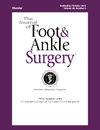Subtalar arthroereisis correction of adolescents flatfoot combined with pelvic obliquity: A retrospective study
IF 1.3
4区 医学
Q2 Medicine
引用次数: 0
Abstract
Adolescent flexible flatfoot can result in structural deformities such as medial arch collapse, hindfoot valgus, and forefoot abduction, leading to fatigue and pain. Additionally, some patients develop pelvic obliquity, associated with lower back and hip discomfort. This study evaluates the clinical efficacy of subtalar arthroereisis in treating adolescent flexible flatfoot with pelvic obliquity. Thirty-two patients (mean age 11.0 ± 1.6 years) with flexible flatfoot and pelvic obliquity underwent subtalar arthroereisis. Radiological assessments of pelvic distance, pelvic tilt angle, Meary angle, Pitch angle, and ankle mortise distance were conducted preoperatively and at 3 months, 1 year, and 2 years postoperatively. Statistical analysis included the Wilcoxon rank-sum test and Spearman's correlation. Significant improvements were observed postoperatively in all measured angles and distances (P < 0.001). Notable continued improvements were seen up to 2 years, particularly in pelvic distance (Z = -3.413, P < 0.001) and ankle mortise distance (Z = -2.804, P = 0.003), with no recurrence. Correlations between ankle mortise distance and pelvic parameters were consistently significant across all follow-up periods. Subtalar arthroereisis is effective in treating flexible flatfoot and improves associated pelvic obliquity, with sustained benefits observed over a 2-year follow-up.
青少年平足合并骨盆倾斜的距下关节挛缩矫治:回顾性研究。
青少年柔性扁平足可导致结构畸形,如内侧足弓塌陷、后脚外翻和前脚外展,导致疲劳和疼痛。此外,一些患者出现骨盆倾斜,伴有下背部和臀部不适。本研究评估距下关节挛缩治疗青少年伴骨盆倾斜的软性扁平足的临床疗效。32例(平均年龄11.0±1.6岁)伴有屈曲扁平足和骨盆倾斜的患者行距下关节挛缩。术前、术后3个月、1年、2年对骨盆距离、骨盆倾斜角、Meary角、Pitch角、踝榫距离进行影像学评估。统计分析包括Wilcoxon秩和检验和Spearman相关检验。术后所有测量角度和距离均有显著改善(P < 0.001)。术后2年持续改善显著,尤其是骨盆距离(Z = -3.413, P < 0.001)和踝关节间距(Z = -2.804, P = 0.003),无复发。在所有随访期间,踝关节榫距和骨盆参数之间的相关性一直很显著。距下关节挛缩是治疗软性扁平足的有效方法,可改善相关的骨盆倾斜,在2年的随访中观察到持续的益处。
本文章由计算机程序翻译,如有差异,请以英文原文为准。
求助全文
约1分钟内获得全文
求助全文
来源期刊

Journal of Foot & Ankle Surgery
ORTHOPEDICS-SURGERY
CiteScore
2.30
自引率
7.70%
发文量
234
审稿时长
29.8 weeks
期刊介绍:
The Journal of Foot & Ankle Surgery is the leading source for original, clinically-focused articles on the surgical and medical management of the foot and ankle. Each bi-monthly, peer-reviewed issue addresses relevant topics to the profession, such as: adult reconstruction of the forefoot; adult reconstruction of the hindfoot and ankle; diabetes; medicine/rheumatology; pediatrics; research; sports medicine; trauma; and tumors.
 求助内容:
求助内容: 应助结果提醒方式:
应助结果提醒方式:


